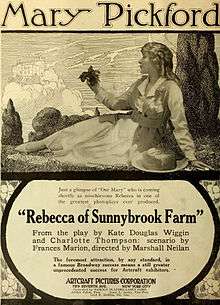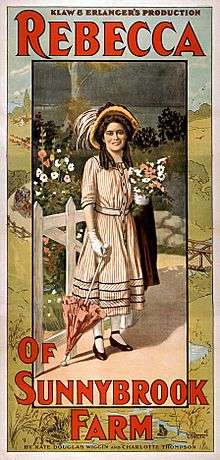Rebecca of Sunnybrook Farm
 | |
| Author | Kate Douglas Wiggin |
|---|---|
| Country | United States |
| Language | English |
| Genre | Children's novel |
| Publisher | Houghton Mifflin |
Publication date | 1903 |
| Media type | Print (Hardback |
| OCLC | 4738229 |
Rebecca of Sunnybrook Farm is a classic American 1903 children's novel by Kate Douglas Wiggin that tells the story of Rebecca Rowena Randall and her two stern aunts in the fictional village of Riverboro, Maine. Rebecca's joy for life inspires her aunts, but she faces many trials in her young life, gaining wisdom and understanding. Wiggin wrote a sequel, New Chronicles of Rebecca.[1] Eric Wiggin, a great nephew of the author, wrote updated versions of several Rebecca books, including a concluding story. The story was adapted for the theatrical stage, and was filmed three times, once with Shirley Temple in the title role.
Synopsis
The novel opens with Rebecca's journey to Riverboro, to live with her two aunts, Miranda and Jane Sawyer. Until this time, she has lived on the family farm. Rebecca is the second eldest of seven children. Most of the children have fanciful names, such as Marquis and Jenny Lind, influenced by their father's artistic background (Rebecca is named after both the heroines in Ivanhoe). The family is quite poor, due to the number of children, Mr. Randall's inability to stick to a job, and the farm being mortgaged. At the beginning of the novel, he has been dead for three years and the family is barely scraping by. Rebecca's stay with her aunt is a chance to improve her opportunities in life and to ease the strain on her family's budget, with one less mouth to feed. Despite her impoverished background, Rebecca is imaginative and charming. She often composes little poems and songs to express her feelings or to amuse her younger brothers and sisters. It is she who named their farm "Sunnybrook".
Miranda and Jane had wanted Hannah, the eldest sister, due to her pragmatic nature and household skills, but her mother needs her at home for the same reason. She sends Rebecca instead. Miranda is unimpressed by Rebecca's imagination and sallow complexion and says she's the image of her shiftless father, Lorenzo DeMedici Randall. Miranda determines to do her duty and train Rebecca to be a proper young lady, so she will not shame the Sawyer name. Jane takes on the role of Rebecca's protector and acts as a buffer between her niece and her sister. Jane teaches Rebecca to sew, cook and manage a household. Rebecca's liveliness and curiosity brighten Jane's life and refresh her spirit. Although Rebecca strives to win Miranda's approval she finds it hard to live up to Miranda's rigid standards. Rebecca is up against Miranda's view of her as "all Randall and no Sawyer".
The middle of the novel is for the most part a description of life at Riverboro and its inhabitants. Important characters are Jeremiah Cobb and his wife Sarah, who first encounter Rebecca's charm; Rebecca's schoolfellow and best friend, Emma Jane Perkins; and Adam Ladd, a young businessman who takes an interest in Rebecca's education. Adam meets Rebecca when she and Emma Jane are selling soap to help a poor family receive a lamp as a premium. Rebecca nicknames him "Mr. Aladdin".

Rebecca proves to be a good student, especially in English, and goes on to attend high school in Wareham. In the last section of the book Rebecca has become a young lady with the same high spirit and a talent for writing. She applies for a teaching place in Augusta, but her mother falls ill and Rebecca must return to care for her and the farm. While Rebecca is away from Riverboro, Miranda dies and leaves the Sawyer house and land to Rebecca. A railway company will buy Sunnybrook Farm for construction purposes and this gives the Randall family a sufficient living. Thanks to Miranda's will, Rebecca now has enough money to become an independent woman and help her siblings. The novel ends with her exclaiming, "God bless Aunt Miranda! God bless the brick house that was! God bless the brick house that is to be!"
Adaptations
Play
Rebecca of Sunnybrook Farm was dramatized for the theater in 1909. Wiggin co-wrote the play with Charlotte Thompson. It was produced for Broadway by Klaw & Erlanger in 1909.[2] Before opening on Broadway, it toured Boston and New England where it was warmly received.[3]
Film
The story was filmed three times. Shirley Temple played Rebecca in the more freely interpreted adaptation of 1938.
- Rebecca of Sunnybrook Farm (1917 film)
- Rebecca of Sunnybrook Farm (1932 film)
- Rebecca of Sunnybrook Farm (1938 film)
Cultural references
- The character of Rebecca has become emblematic, and is applied derogatorily to anyone who is unduly relentlessly optimistic.
- Becky Randall appears as a character in The League of Extraordinary Gentlemen by Alan Moore and Kevin O'Neill.
- In the first season episode of Melrose Place, "Pas de Trois", Alison complains how her colleague Amanda views her as "some kind of Rebecca of Sunnybrook Farm", as an example of an innocent, inexperienced young woman.
- The Japanese band Rebecca takes its name from this novel.
- In an episode of That's My Mama titled "Clifton's Dubious Romance," Clifton's girlfriend has not been honest about her sordid past and he claims she passed herself off as Rebecca of Sunnybrook Farm.
- In an episode of The Golden Girls,"Blanche's Little Girl", Rebecca's fiance Jeremy was upset because they were running late getting to the airport, and she was taking too long to say good-bye; he enters the house to say, "Look, I know things run a little slow here at Sunnybrook Farm, but we do have a plane to catch", using the significance of the name, "Rebecca".
- In the Nancy Drew computer game "Secret of the Old Clock," Nancy must deliver a telegram to "Miss Jane," referring to Rebecca's aunt Jane, at Sunnybrook Farm. When Nancy drops off the telegram, a young girl who introduces herself as Rebecca promises to give it to Jane.
- In the season 2 finale of Gilmore Girls, Paris Gellar asks Rory to be her running-mate for student body president in order to soften Paris' dictatorial image. "That is exactly what I need from you: Rebecca of Sunnybrook Farm for the new millennium. Hey, wear some braids tomorrow with bows. I mean, hell, let's sell it, sister!"
References
- ↑ New Chronicles of Rebecca, Kate Douglas Wiggin, Houghton, Mifflin and Company, The Riverside Press, Cambridge, April 1907, copyright 1906 and 1907 by Charles Scribner's Books, copyright 1907 Kate Douglas Wiggin, reprinted in June 1986 by Buccaneer Books, ISBN 0-89966-572-1.
- ↑ "PLAY FROM 'REBECCA' BOOKS.; Klaw & Erlanger Produce "Rebecca of Sunnybrook Farm"" (subscription). The New York Times. November 17, 1909. p. 11. Retrieved 2007-06-13.
- ↑ Burbank, Emily M. (October 22, 1910). "REBECCA OF SUNNYBROOK; How Kate Douglas Wiggin Was Induced to Turn Her Enormously Popular Books Into a Play" (subscription). The New York Times Saturday Review of Books. p. BR1. Retrieved 2007-06-13.
External links
- Rebecca of Sunnybrook Farm at Project Gutenberg
- Wiggin, Kate Douglas (1995). Rebecca of Sunnybrook Farm (reissue ed.). Puffin. ISBN 0-14-036759-4.